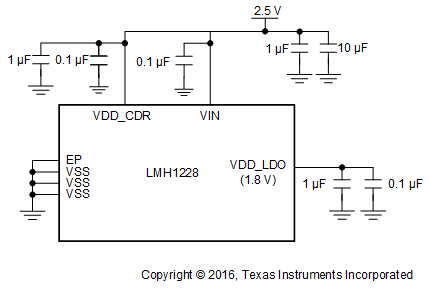SNLS568D March 2017 – May 2020 LMH1228
PRODUCTION DATA.
- 1 Features
- 2 Applications
- 3 Description
- 4 Revision History
- 5 Pin Configuration and Functions
- 6 Specifications
-
7 Detailed Description
- 7.1 Overview
- 7.2 Functional Block Diagram
- 7.3
Feature Description
- 7.3.1 4-Level Input Pins and Thresholds
- 7.3.2 OUT0_SEL and SDI_OUT2_SEL Control
- 7.3.3 Input Signal Detect
- 7.3.4 Continuous Time Linear Equalizer (CTLE)
- 7.3.5 Clock and Data (CDR) Recovery
- 7.3.6 Internal Eye Opening Monitor (EOM)
- 7.3.7 Output Function Control
- 7.3.8 Output Driver Control
- 7.3.9 Status Indicators and Interrupts
- 7.4 Device Functional Modes
- 7.5 Register Maps
- 8 Application and Implementation
- 9 Power Supply Recommendations
- 10Layout
- 11Device and Documentation Support
- 12Mechanical, Packaging, and Orderable Information
Package Options
Mechanical Data (Package|Pins)
- RTV|32
Thermal pad, mechanical data (Package|Pins)
- RTV|32
Orderable Information
9 Power Supply Recommendations
The LMH1228 requires decoupling capacitors to ensure a stable power supply. For power supply decoupling, 0.1-μF surface-mount ceramic capacitors must be placed close to each VDD_CDR, VDD_LDO, and VIN supply pin to VSS. Larger bulk capacitors (for example, 10 μF and 1 μF) are recommended for VDD_CDR and VIN.
 Figure 41. Recommended Power Supply Decoupling
Figure 41. Recommended Power Supply Decoupling Good supply bypassing requires low inductance capacitors. This can be achieved through an array of multiple small body size surface-mount bypass capacitors to keep low supply impedance. Better results can be achieved through the use of a buried capacitor formed by a VDD and VSS plane separated by 2 to 4 mil dielectric in a printed-circuit board.